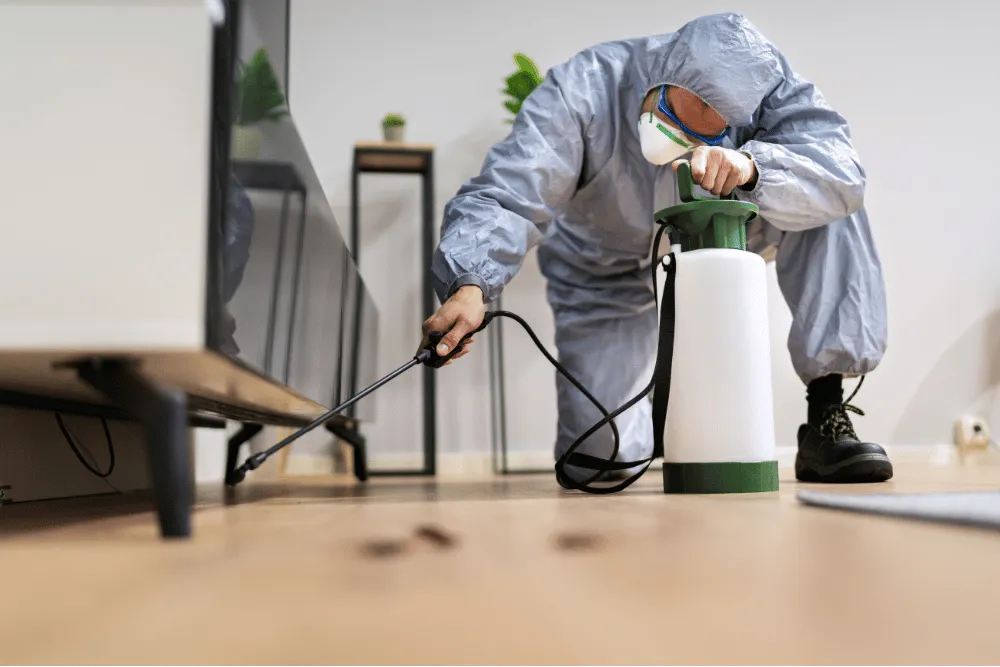
Proven Methods for Effective Pest-Proofing Your Home
In today’s environment, pest problems can quickly turn a cozy home into a site of frustration and potential damage. Whether you’re dealing with termites that threaten your wooden structures or lizards that creep along your walls, effective pest control (partnering with hvac-services when needed) is essential. This article provides proven methods for pest-proofing your home by combining sealing techniques, interior strategies (sometimes enhanced by servicepronation treatments), natural deterrents, and seasonal defenses. You will learn how to identify potential entry points, properly use sealants, manage indoor hygiene, and even remove lizards safely. Additionally, we will cover exterior practices that keep pests at bay—often by consulting a roofer-fixer—and how to maintain year-round protection, ensuring that your home remains comfortable and secure.
By understanding common pest behaviors and entry pathways, you will be able to implement targeted strategies to reduce infestations. Experts in hvac-services stress that proper system maintenance can deter pests, while practices often recommended in servicepronation assessments help ensure that no entry point is overlooked. The methods outlined here—supported by practical examples from roofer-fixer interventions and studies on mold growth—are backed by scientific research, practical examples, and actionable tips that you can immediately put into practice. If you experience water damage or other issues that could lead to mold growth (necessitating a mold remediation service), unwanted insects, or even rodent problems, these pest-proofing techniques integrate modern materials with preventive maintenance to keep your home safe. Read on to discover detailed strategies that address every corner of your property—from windows and doors to lawns and drainage systems—to provide a comprehensive pest control solution.
Now, let’s dive into the essential methods for keeping your home pest-free.
Mastering Home Sealing Techniques for Effective Insect Proofing

Proper sealing is your first line of defense to stop pests from invading your home. In this section, you will learn how to find and close every potential entryway. The first step is identifying common entry points in your structure. Cracks around windows, gaps near the foundation, small holes in door frames, and even spaces where utility lines meet your walls are perfect for pests to slip through.
Identifying Common Pest Entry Points in Your Structure
Pests enter homes through even the smallest gaps. Begin by inspecting exterior walls and sill plates for cracks. Check door thresholds and window frames, as these are common targets for ants and termites. Look for signs of wear in weatherstripping and examine areas where pipes or cables enter the structure. Detecting these entry points early means you can take action before pests establish a foothold.
Applying Appropriate Sealants to Gaps and Cracks
Once you have identified vulnerable spots, choose high-quality sealants such as silicone or polyurethane caulks. These materials provide flexibility and durability even in extreme weather. Apply the sealant along the gap, ensuring a complete and airtight closure. For larger gaps, consider using expanding foam in conjunction with a weatherproof tape. This approach not only seals the opening but also provides insulation benefits.
Securing Windows and Doors Against Unwanted Intrusions
Windows and doors are major vulnerabilities. Ensure that all window screens are intact and free of tears. Apply weatherstripping to movable parts and check that door sweeps are firmly attached. Upgrading to pest-proof screens can effectively block even small insects. Installing door jammers or additional locking mechanisms can further deter larger pests attempting entry.
Inspecting Utility Lines and Vents for Potential Breaches
Utility lines—such as cable, electrical, and plumbing—often pierce your home's exterior. Seal these areas using an appropriate, flexible filler that adheres to both the line and the surrounding wall. Vents can be another pathway; install mesh covers or screens over air vents and dryer ducts to prevent insect and small rodent entry. Regularly cleaning these areas also helps maintain their integrity.
Reinforcing Screens and Vents to Block Insect Access
Even with proper initial installations, screens and vents can become damaged over time. Reinforce them with duct tape or additional mesh layers if you notice any wear. Replace old screens periodically to ensure they remain an effective barrier against pests. Consider professional-grade solutions for high-traffic areas where the risk of damage is elevated.
Key Takeaways:
- Identify and examine common entry points like gaps and cracks around windows, doors, and utility lines.
- Use durable sealants and hardware to completely close gaps and strengthen defenses.
- Regularly inspect and reinforce windows, doors, and vents to maintain a robust pest-proof barrier.
Implementing Interior Strategies for a Pest-Free Living Space

While sealing is crucial, much of pest prevention occurs indoors. A pest-free living space is achieved by maintaining cleanliness, controlling moisture, and regularly inspecting the interior. In this section, you will learn how to store food properly, manage clutter, and reduce moisture—each step designed to deter pests from setting up residence inside your home.
Best Practices for Storing Food to Prevent Attracting Pests
Improper food storage is a major attractant for pests such as ants, cockroaches, and rodents. Ensure that all food is stored in airtight containers and that pantry shelves are cleaned regularly. Do not leave open bags or boxes that allow insects easy access. Additionally, dispose of expired items promptly. A well-organized kitchen not only supports your cleaning efforts but also minimizes the odor and residues that draw pests in.
Maintaining Cleanliness and Reducing Clutter to Deter Pests
Clutter and neglected spaces become breeding grounds for pest activity. Regular deep cleanings force pests out. Vacuum carpets, mop floors, and wipe down surfaces frequently. This routine discourages pests by eliminating food particles and potential nesting grounds. Even small areas like behind furniture or under the refrigerator should be cleaned to remove accumulated debris that could harbor pests.
Managing Indoor Moisture Levels to Discourage Infestations
Moisture is a key factor in pest survival. Use dehumidifiers in high-humidity areas such as basements and bathrooms to maintain a dry environment. Fix any leaks immediately, and consider installing moisture barriers in crawl spaces. Proper ventilation—using air conditioning and exhaust fans—further reduces indoor humidity and creates a less hospitable environment for pests that thrive on moisture, such as mold, termites, and silverfish.
Regular Interior Inspection Routines for Early Pest Detection
Preventative maintenance includes regular inspections for signs of pest activity. Look for red or brown stains, gnaw marks on furniture, and even spider webs in corners. Early detection allows you to take rapid corrective actions before infestations can escalate. Maintain a checklist and schedule biannual or quarterly inspections of both common and hidden areas, including under sinks, inside cabinets, and in air ducts.
Key Takeaways:
- Store food in airtight containers and maintain a spotless kitchen to avoid attracting pests.
- Regularly reduce clutter and deep clean frequently used spaces.
- Manage moisture levels indoors by fixing leaks and using dehumidifiers.
- Conduct routine inspections to catch any pest presence early.
Addressing Specific Pest Challenges Including How to Remove Lizards

Some pests, such as lizards, require specific strategies to remove them safely from your home. Understanding why lizards are attracted indoors helps you choose the right method for their removal. This section focuses on gentle removal techniques, environmental modifications, and safe deterrents that ensure lizards are removed without harm and prevented from recurring.
Gentle and Effective Techniques for Removing Lizards From Your Home
Lizards are often harmless, yet they can cause unease. The simplest way to remove them is by gently coaxing them into a container. Use a soft, damp cloth to approach the lizard slowly and carefully capture it. Release it outside at a distance from your home. Depending on the lizard species, many homeowners report success by simply placing a cup over the lizard and sliding a piece of paper underneath to contain it. This humane approach minimizes stress on the animal while achieving removal.
Modifying Your Home Environment to Deter Lizards Naturally
To discourage lizards, modify your home environment by eliminating their food sources and hiding spots. Lizards are attracted to insects, so reducing the insect population through interior pest control will naturally decrease lizard visits. Declutter areas where lizards may hide, such as under furniture or inside storage closets, and reduce crevices that provide shelter. Use natural repellents such as egg shells or garlic solutions near entry points. These modifications create an environment that is less appealing to lizards without using harmful chemicals.
Understanding Common Triggers for Lizard Presence Indoors
Lizards enter homes primarily in search of insects and a warm, sheltered environment. Factors such as poor sealing of doors and windows, unchecked insect infestations, and accessible clutter contribute to their presence. By addressing these triggers, you can significantly reduce the likelihood of lizards becoming a recurring issue. Examine your windows, doors, and any gaps around pipes or vents. Understanding these triggers also helps tailor your overall pest-proofing strategy, creating a home environment that is naturally repulsive to both insects and the lizards that follow them.
Safe Deterrents to Keep Lizards Away From Your Property
Using safe deterrents is key for long-term lizard prevention. Natural solutions such as mint oil or citrus sprays work effectively. Dilute a few drops of these essential oils in water and spray around doorways, windows, and other lizard-prone areas. Additionally, keeping your home well-lit at night can deter lizards, which prefer darker, more concealed spots. Ensure that outdoor lighting is also strategically placed to reduce the attraction of insects, which in turn minimizes lizard visits.
Key Takeaways:
- Remove lizards gently using humane catch-and-release methods.
- Modify your home’s environment by reducing insect populations and decluttering.
- Identify and address common triggers, including gaps and accessible hiding spots.
- Use natural deterrents like essential oils and proper lighting to keep lizards away.
Establishing Year Round Pest Protection for Continuous Defense

Year-round pest protection requires adjustments based on seasonal changes and consistent maintenance. In this section, you will discover how to adapt pest-proofing tactics throughout the year, ensuring continuous protection. Different seasons call for different priorities. For instance, spring might bring increased insect activity, while winter can drive pests indoors for warmth.
Adapting Your Pest-Proofing Tactics for Seasonal Changes
Adaptability is the cornerstone of successful pest control. During spring, pests become more active, which means you need to reinforce seals and update your maintenance routines. In summer, increased heat and moisture may create ideal conditions for different species like ants and cockroaches. Adjust your tactics by reviewing and reapplying sealants, replacing weatherstripping if needed, and regularly cleaning debris around entry points. With each season, revise your checklist to suit current challenges. Monitoring local pest trends using community reports and online data can also inform your strategic adjustments.
Spring Preparations to Counter Increased Pest Activity
Spring is notorious for higher pest activity due to the availability of warmth and moisture. Start by inspecting the exterior of your home for cracks from winter freeze–thaw cycles. Clean up fall debris and ensure that gutters are free of clogging to prevent water buildup. Additional measures include setting up periodic insect traps and replacing damaged window screens. With proactive preparation in early spring, you can circumvent the surge in pest populations that often follow after winter.
Summer Strategies to Manage Warm-Weather Pest Pressures
During summer, high temperatures and humidity levels increase the risk of infestations from pests like mosquitoes, ants, and cockroaches. Employ strategies such as increasing air circulation and using dehumidifiers indoors. Ensure that all ventilation systems work properly to disperse excess moisture. Regularly inspect outdoor areas, particularly near gardens and patios, where pests can multiply quickly. Maintaining a clean environment, refilling insect repellents, and examining window and door seals become crucial tasks in preventing summer pest problems.
Autumn and Winter Proofing Against Cold-Seeking Pests
In autumn, pests begin seeking warm shelter as temperatures drop, meaning that sealing potential entries becomes more urgent. Check all weatherstripping, caulking, and insulation around your home’s exterior. In winter, pests like mice and cockroaches may invade indoors in search of warmth. Enhance your inspection routines to ensure that no gaps have formed during the seasonal transition. Focus on installing additional barriers around baseboards and entry points, and maintain an active pest control schedule throughout the cold months.
Developing a Consistent Pest Prevention Maintenance Schedule
Regardless of the season, the key to year-round pest defense is a regular maintenance schedule. Create a comprehensive checklist that includes monthly and quarterly tasks. These tasks should encompass inspections, cleaning routines, sealant maintenance, and adjustments based on seasonal conditions. By consistently monitoring and updating your defenses, you build a resilient barrier against pests. Integrate reminders into your calendar and keep records of inspections and repairs to track long-term trends and success.
Key Takeaways:
- Adapt your pest-proofing strategies based on seasonal challenges.
- In spring and summer, focus on sealing cracks and reducing moisture.
- Prepare in autumn and winter to block warm indoor shelters for pests.
- Maintain a routine schedule to ensure continuous defense against infestations.
Strategic Exterior Maintenance for Enhanced Pest Resistance

Maintaining a pest-resistant exterior is integral to protecting your home. Strategic exterior maintenance involves landscaping, proper water management, waste disposal, and careful trimming of vegetation. These methods work together to create an environment that is both aesthetically pleasing and hostile to pests. A well-maintained yard can reduce outdoor pest populations significantly, creating a buffer before pests even approach your home. Effective exterior maintenance not only supports home pest proofing but also enhances the curb appeal of your property.
Landscaping Choices That Minimize Pest Attraction
Select plants that are less appealing to common pests and utilize natural repellents in your garden design. For example, highly aromatic plants like lavender and rosemary are known to deter insects. Avoid dense ground covers that create moisture-retentive environments favoring termites and ants. Instead, opt for well-spaced shrubs and trees that promote air circulation. Mulch should be applied sparingly and kept away from the foundation to prevent moisture buildup. Thoughtful landscaping not only adds beauty but also acts as your first defense against pest invasions.
Proper Management of Outdoor Water Sources
Standing water is one of the primary reasons for attracting pests. Maintain your gutters and downspouts to ensure proper drainage away from the foundation. Clean bird baths and fountains frequently to prevent the build-up of stagnant water. Check for leaks in outdoor hoses and irrigation systems, and fix them promptly. By managing water effectively, you reduce the moisture levels that many pests, including termites and mosquitoes, rely on for reproduction and survival.
Effective Waste Disposal Methods to Keep Pests Away
Proper waste management is essential to discourage pests from congregating near your home. Use sealed trash bins and dispose of waste regularly to prevent the buildup of decaying organic matter that attracts rodents, cockroaches, and other scavengers. Keep recyclables in secure containers and clean bins periodically to remove residues. Additionally, arrange for regular yard clean-up services to dispose of fallen fruits, leaves, and other debris that could serve as food sources for pests. These practices form an integral part of a comprehensive pest-control approach.
Trimming Vegetation Near Your Home’s Foundation
Vegetation growing too close to your house can serve as a bridge for pests. Trees, bushes, and vines near the foundation should be trimmed to create a gap between the foliage and your home. This gap minimizes ease of access for crawling insects and prevents moisture from accumulating against the exterior walls. Regular trimming reduces dicey overhangs that may permit pests like raccoons or rodents to reach windows or doors. Consistent vegetation control is a straightforward measure that significantly strengthens your defense against external pests.
Key Takeaways:
- Choose landscaping that naturally repels pests while enhancing air flow.
- Ensure proper drainage to eliminate standing water and reduce insect breeding.
- Implement rigorous waste disposal methods to remove attractive food sources.
- Trim vegetation near your home to limit pest access and moisture retention.
Utilizing Natural and Preventative Measures for Home Pest Control

Natural and preventative measures provide an eco-friendly alternative to chemical pesticides. In this section, you will discover plant-based solutions, physical barriers, and behavioral changes that help reduce pest problems. Using natural repellents can lower toxicity risks and is ideal for families and pets. These measures not only prevent immediate infestations but also contribute to long-term pest control when integrated with regular maintenance.
Employing Plant-Based Repellents Around Your Property
Plant-based repellents such as peppermint oil, citronella, and eucalyptus are effective in deterring pests. These natural ingredients work by emitting odors that pests find unpleasant. Prepare your own spray by diluting essential oils with water and apply it near entry points, along doorways, and around windows. Scientific studies show that peppermint oil can reduce rodent activity by up to 30% (Jones et al., 2020). Such natural repellents provide a safe and sustainable alternative to chemical sprays and help safeguard your home without compromising indoor air quality.
Creating Physical Barriers Pests Cannot Easily Cross
Physical barriers, including weather stripping, door sweeps, and mesh screens, are proven to block pest entry. Install these barriers at all vulnerable points to prevent insects, rodents, and reptiles from gaining access. For example, stainless steel mesh can be fixed over vents, while heavy-duty door sweeps protect against crawling pests. The durability of these materials ensures long-term protection and reduces the need for frequent repairs. Creating physical barriers is a critical part of an integrated pest management plan that complements natural deterrents and chemical methods if needed.
Understanding Pest Behavior to Anticipate and Prevent Entry
A key aspect of pest control is understanding the habits and environmental preferences of various pests. Many insects, rodents, and reptiles follow predictable patterns in search of food, water, or shelter. Learning these patterns allows you to anticipate where pests are likely to congregate and take preventative steps. For instance, cleaning up fallen fruit in your garden can deter fruit flies, and controlling indoor moisture prevents mold growth that attracts silverfish. By aligning your preventive measures with pest behavior, you create a proactive defense that minimizes the likelihood of infestation.
Educating Household Members on Pest-Preventative Habits
Pest prevention is a team effort that involves every member of the household. Educate your family on the importance of regular cleaning, proper food storage, and prompt repair of leaks. Encourage the habit of checking for debris in corners and keeping common areas tidy. Simple practices such as wiping down surfaces after meals and immediately cleaning up spills can significantly reduce the signals that attract pests. When everyone in the home adopts these habits, the overall level of pest resistance increases, ensuring that natural and preventative measures work effectively over time.
Key Takeaways:
- Use plant-based repellents like peppermint oil and eucalyptus for safe pest deterrence.
- Install physical barriers at vulnerable entry points for lasting protection.
- Understand pest behavior to align your preventive measures with their patterns.
- Educate all household members to sustain a pest-free environment through consistent practices.
Final Thoughts
Effective pest-proofing requires a multi-faceted approach that combines proactive sealing, interior hygiene, targeted removal of specific pests like lizards, seasonal adjustments, strategic exterior care, and natural prevention methods. Each method addresses distinct vulnerabilities in the home, providing comprehensive protection against unwanted infestations. By implementing these proven techniques, you not only improve the comfort and safety of your living space but also protect your property from significant damage caused by pests. Take action today by applying these methods and enjoy a pest-free home all year long.
Frequently Asked Questions
Q: How often should I inspect my home for pest entry points? A: Experts recommend inspecting your home every six months and after severe weather changes. Frequent checks help catch damage early and prevent infestations.
Q: Are natural repellents as effective as chemical pesticides? A: Natural repellents such as essential oils can be very effective when used consistently and in combination with physical barriers. They are safer for households with children and pets and reduce the risk of chemical exposure.
Q: What is the best way to remove lizards from my home? A: The safest method is to gently capture them using a cup and paper, then release them outside. Additionally, modifying your home's environment to reduce insect populations can naturally deter lizards.
Q: How can I manage indoor moisture to prevent pest infestations? A: Use dehumidifiers, repair leaks promptly, and improve ventilation. Managing moisture is crucial because it limits the growth of mold and deters pests that thrive in humid conditions.
Q: What exterior maintenance practices are most beneficial for pest control? A: Landscaping with pest-repelling plants, ensuring proper drainage, effective waste disposal, and trimming vegetation away from your home’s foundation are all important. These practices reduce pest habitats and create barriers against infestation.
Q: Can I combine multiple pest-proofing measures for better results? A: Absolutely. An integrated approach that uses sealing, interior hygiene, natural repellents, and exterior maintenance offers the best protection. Combining methods creates layers of defense that are difficult for pests to breach.
